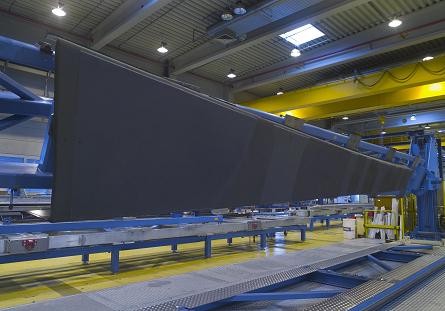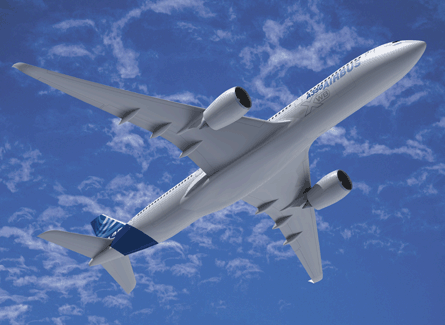Airbus's UK plant in Broughton, North Wales is justifiably proud of the fact that it will be responsible for assembling the first composite wings for a European airliner - the A350 XWB. That most of the components will be coming from outside Wales, and the UK for that matter, is however a cause for concern - one that it hopes to address for the next programme through its experience with the A350 and the UK government's Next Generation Composite Wing project.
STRATEGIC PROGRAMME
"The A350 wing assembly is a very strategic programme [for the UK]," says Brian Fleet, who heads Airbus's wing and pylon centre of excellence. Describing Broughton as the centre of excellence for wing manufacturing, not just in Europe but the world, Fleet feels the A350 is the vital opportunity for the UK "to rapidly catch up with the rest of Europe with regard to composite design and manufacture".
Fleet, who joined the Broughton factory in 1974 as an engineer when it was known as the Chester plant within the Hawker Siddeley empire, says he had to work his "cotton socks off" to secure the A350 work for the UK. "This programme will run for the next 40-50 years and will create employment not just for our children, but our children's children," he says.
 |
|---|
It is almost three years since EADS took over full ownership of Airbus when BAE Systems divested its 20% shareholding in the airframer. Fleet says that during its last years within Airbus, BAE had little involvement in Broughton and since its departure "nothing really has changed operationally".
Broughton, in Flintshire, is the larger of Airbus's two UK plants, has a workforce of more than 6,000 people (including 1,400 subcontractors) and is responsible for subassembly of large wing components and final assembly of wing boxes for commercial aircraft in the airframer's product range. As a legacy of its old Hawker Siddeley days, Broughton also produces wings and fuselages forthe Hawker 750/850/900 business jet, and the rapid slowdown suffered in this sector has hitthe Broughton workforce, with the airframer revealing that it is looking to reduce its subcontractor count at the site by about250 people.
Airbus's other UK plant, at Filton near Bristol, has 4,100 employees - mainly engineers working on wing design and engineering - while 1,500 of their former colleagues now work for GKN following the sale of Filton's manufacturing operation as part of the group's restructuring. Filton is also the site for the one Airbus wing assembly line outside Broughton, that of the A400M military transport.
In support of its role as the Airbus civil wing assembly plant, the Welsh factory's manufacturing functions include machining of stringers, wing skin panels, spars and forming of stringers and skins, as well as treatments. Subassembly work includes wing panel robot drilling, assembly (manual and automatic - the latter using low voltage electromagnetic riveting machinery) and sealing. "75% of production at Broughton concentrates on high-value added manufacturing," says Flint.
It is hard to overstate the importance of Broughton's wing work to UK industry, which Fleet says secures 135,000 jobs across the nation: "Although we buy worldwide, the vast majority of our spend is in the UK, therefore the health of Airbus is fundamental to the health of the aerospace sector in the UK. We are the prime for the first, second and third tier suppliers and without that prime being here, that opportunity would be very limited."
LOCAL EMPLOYMENT
For the UK, Airbus's presence means "high technology employment", says Flint. He says Airbus plays an important role in local employment beyond its own boundaries. "Airbus spends around €8 million ($10.8 million) a week in the local economy. We have 170 local suppliers in the Flintshire area. Three of the five factories on a newly created nearby business park are occupied by Airbus suppliers."
 |
|---|
© Airbus |
So it is no surprise Airbus has again sought some financial assistance from the Welsh Assembly for the expansion it is undertaking for the A350. Fleet emphasises this is not direct support - as that could fall foul of World Trade Organisation subsidy rules - but covers infrastructure issues such as training initiatives and coping with the increased electricity requirements necessary as the site grows.
Airbus took a bold step at Broughton almost a decade ago, investing €770 million in a new state-of-the-art facility - dubbed the "West Factory" - to undertake wing assembly and equipping for the A380. Broughton also produces almost the all the panels for the A380's aluminium wing covers. That programme has generated over £15 billion ($21.6 billion) worth of work with over 2,000 suppliers in the UK, says Flint, and combined with other Airbus programmes contributes over £1.5 billion a year to the nation's net trade balance.
A similar bold move is about to get under way for A350, with construction of a new purpose-built 58,500m2 (630,000ft2) €400-plus million assembly hall due to be completed by early next year.
The A350's carbonfibre wing is the most advanced ever produced in Europe and will expose Broughton to important new structures technology. "While the aircraft is greater than 50% composite, the wing is greater than 80% composite," says Fleet. All major structural components of the torsion box are composite - the covers (or skins), stringer and spars - as are all the moveable surfaces and all the secondary structure. "The wing is driving the major contribution to the weight and performance of the A350," he adds.
But although Broughton will assemble the A350 wing box, unlike its other Airbus programmes, component manufacturing and subassembly work has been allocated to a mix of other Airbus divisions and outside suppliers. Fleet says this decision was driven by the size of the task that the Broughton factory faces simply gearing up to build its first carbonfibre wing: "This will be the first time Broughton has ever been involved in composite manufacturing. To give us the burden of other tasks would be too much at this time."
 |
|---|
© Airbus |
But Fleet believes the experience from the A350 should provide the necessary building blocks to ensure the UK is better positioned in the carbonfibre manufacturing sector when the workshare is being decided for the next all-new Airbus programme, which is likely to be the A320 replacement dubbed "A30X".
"Our European counterparts have been working in composites for the last 20 years. The UK needs to ensure that the gap is closed and the A350 is our catch-up programme. We must make sure composite capabilities are developed over the next few years so that the UK is in a position to compete for the work on A30X.
"This started with the A400M, which has been a great learning aid and people involved have been redeployed to the A350. We will learn a lot for 'A30X' from A350 and the work being done under the UK's Next Generation Composite Wing project."
This £100 million initiative was launched in 2008 and is an Airbus-led collaboration between 17 UK research organisations and companies, including GKN. It aims to develop the technology needed to ensure the UK is prominent in the design and manufacture of wings for next-generation single-aisle aircraft.
It is important the UK works hard to build its composite competency as it faces competition not just from its Airbus partners but also from outside Europe. Airbus's growing partnership with China will see the wings for the locally built A320s being assembled not in Broughton but at a plant near the Tianjin line.
 |
|---|
Airbus's German plant in Stade and the Illescas plant in Spain will produce, respectively, the A350's top and bottom wing covers. Other key subassembly packages are subcontracted, with GKN's newly acquired Filton factory to produce the fixed trailing edge, while Spirit AeroSystems will build the fixed leading edge in the USA and Scotland.
While Broughton carries out the entire wing-equipping task on the A320 and A380 programmes, its A350 package mirrors that of the A330/A340, where only 20% of the work (pre-equipping) is undertaken in the UK. Like the A330/A340, the bulk of the A350 equipping has been allocated to Airbus's Bremen, Germany plant. Fleet says this decision was a legacy of the allocation for that earlier programme, as the A350 is effectively the replacement in Airbus's product line for the A330/A340.
Broughton aims to reduce the wing-build cycle and costs by 30% on the A350, but must also undertake a rapid ramp-up and be capable of high production rates of up to 13 aircraft a month, says Fleet. The assembly process has been revised with a pulse line and fully horizontal build-up adopted. "This will give a pace to production, which provides a sense of urgency to the process and drives efficiency."
IMPROVED ERGONOMICS
Horizontal build-up - rather than vertical on the A380 - has better ergonomics, says Fleet, as it means that people are not working at height on the assembly. "It also allows for fully automated drilling and bolting of top and bottom of the wing," he says.
The pulse line means that the wings will move along to various stations at a predetermined rate depending on the output level. "This allows each station to be automated and enables us to reduce the man-hours and cycle time by 30%," says Fleet.
Broughton, like other Airbus plants across Europe, is having to adjust to the downturn. One area hit hard has been the business jet sector after a strong 2008. A record 95 wing and fuselage sets were delivered to Hawker Beechcraft last year, but the rate has been slashed, prompting the need to cutthe number of subcontractors at Broughton.
The Hawker contract, which at its peak has employed 850 blue and white collar Airbus staff, was part of the sale by Broughton's former owner BAE Systems (then British Aerospace) of the 125 business jet programme to Raytheon (since taken on by Hawker Beechcraft).
With the Hawker work being non-core to EADS's business, some observers questionthe long-term future of this part of Broughton's activities. However, Fleet says "it is a life-of-programme contract and is part of our heritage. Airbus and EADS are both more than happy to continue supporting the programme."
So the near-term challenge facing Flint and Broughton is significant - manage the production rates of existing programmes as the downturn bites, but in parallel oversee the creation of infrastructure to build what is arguably the UK and Europe's most challenging and important airliner wing to be built.
Source: Flight International




















